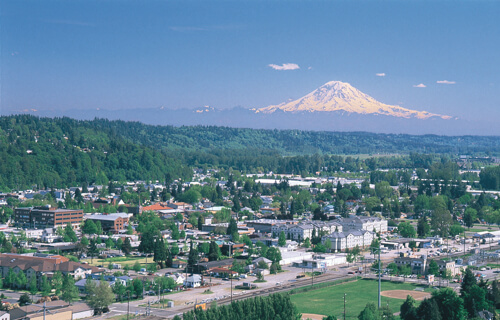
With the recent intense focus on the concerns of the African American community in the nation and the Seattle area, it is worth highlighting the degree to which that community has shifted geographically in recent decades. The locus of protest has largely been within the city of Seattle, and yet Seattle’s regional role as a home for African Americans has diminished sharply in the past 30 years.
First, as a region far from the Southeast, Seattle has historically had a relatively small Black population. Figure 1 shows the Black share of the population for the 30 largest metro areas the in the country.

At 6 percent, the Seattle metro area Black population share is less than half of the national average. And within the city limits of Seattle, the Black population is only about 7 percent. Among the nation’s 100 largest central cities the Black population averages 21 percent, and Seattle ranks 70th within this group.
For several decades the African American population of the region has been steadily moving to the suburbs, especially those in South King County. Figure 2 shows the change in the Black population for the 25 largest cities in the Seattle metro area, ordered by the Black population share in 2018.

Along with the nation and state, the Black population of the Greater Seattle area increased slightly over 30 years. Within the region Seattle’s Black population dropped from 10 percent to 7 percent of the total, and Tacoma’s Black population dropped from 11 to 10 percent. Lakewood, University Place and Kirkland saw a slight drop, but these changes are within the margin of error. Other cities saw the Black share of their populations increase, mostly outside of the margin of error.
Figure 3 shows these changes as numbers.

From 1990 to 2018, Seattle added over 200,000 residents, but had a net loss of 3,000 Black residents. All other cities added Black residents, some in quite large numbers.
Turning to King County, Figure 4 shows the growth in the county’s Black population from 1990 to 2018 by major subareas.

Here we see vividly the shift in the Black population to the large South King County cities. In 1990, 68 percent of King County’s Black population lived within the Seattle city limits, and that had fallen to 33 percent by 2018. (The light blue bar, balance of King County, includes unincorporated areas with large Black populations, such as Skyway and White Center.)
Change in communities is generally led by younger families, so we can see how population shifts are playing out by looking at the demographics of schools. The State Office of the Superintendent of Public Instruction conducts an annual enrollment survey that includes race and ethnicity. Figure 5 shows the results of these surveys for 1993 (first year available) and 2019 for the school districts of King County.

The shifts in school demographics mirror the general population shifts seen in Figure 2. The Black share of the Seattle Public Schools fell from 23 percent in 1993 to 14 percent by 2019. Seattle schools had 2,000 fewer Black students in 2019 than they had in 1993. Meanwhile, the Kent and Federal Way districts each added over 2,000 Black students, Highline added over 1,500 and Auburn added over 1,000. In 1993, 45 percent of the county’s Black students were in suburban districts, rising to 69 percent by 2019.
Historically, as African Americans moved out of the Southeast states, job availability and housing segregation caused them to gravitate to central cities, including Seattle. But in the past generation, a combination of high housing prices and other social change has led many Black families to settle in suburban areas. As African American leaders seek change at the local level, they should include communities beyond Seattle, where a substantial majority of the region’s Black residents now live.
This article is taken from the author’s Puget Sound Indexer, a regional resource for analyzing change.
Discover more from Post Alley
Subscribe to get the latest posts sent to your email.


When I moved into my neighborhood in southeast Seattle, it was almost exactly 1/3 people of Asian descent, 1/3 African Americans and 1/3 white. My white daughters were minorities not only in the public schools they attended from K-12, they were also–and this is very important–minorities in their classrooms in these schools.The only way I was able to make this vitally important part of their education happen was to refrain from enrolling them in programs for so-called gifted students, which have always looked to me like affirmative action programs, operated at public expense, for already advantaged but not necessarily “gifted” white children. If I hadn’t done this, they would have spent their school days living in same privileged world they were born into. Given the people they have become, it was one the smartest decision I’ve ever made about their upbringing.
Today, thanks to gentrification, I look around my neighborhood and see, with one exception, nothing but people who look like me. I might as well move back to Spokane or Montana. In the great scheme of things, my disappointment about watching the diversity drain out of my little world does not even begin to qualify as a tragedy. But it is a very troubling symptom. Or as we’ve been saying in my family, “There went the neighborhood.”